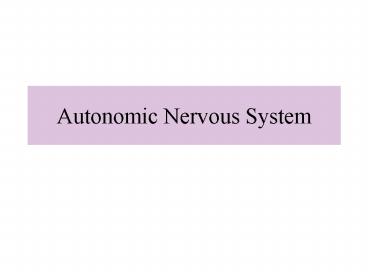Autonomic Nervous System PowerPoint PPT Presentation
Title: Autonomic Nervous System
1
Autonomic Nervous System
2
Autonomic Nervous SystemRef Textbook of
Medical Physiology, Guyton, 12th ed 729-738,
11th ed. P748-760, and 10th ed. p697-708.
3
Fig.17.02
4
General functions
- Control and Adaptation of body systems to
internal and/or external changes
5
Example of adaptation to external stimuli
- Fight and Flight Reaction
- -Increase heart rate and force of contraction.
- -Widely dilated pupils.
- -Pallor (pale of fear) as blood is directed to
the skeletal muscle. - -Goose pimpling.
- -Cold sweat.
- -Dry mouth.
6
(No Transcript)
7
Fig. 17.03
8
Anatomical characteristics and Synaptic
organization of ANS
ANS characteristics
9
Fig.17.02
10
- Axon of 1st (preganglionic) neuron leaves CNS to
synapse with the 2nd (ganglionic) neuron - Axon of 2nd (ganglionic) neuron extends to the
organ it serves
Diagram contrasts somatic (lower) and autonomic
autonomic
this dorsal root ganglion is sensory
somatic
Note the autonomic ganglion is motor
11
Fig.17.01
12
Synaptic organization of ANS
- Convergence and Divergence in Sympathetic division
13
Fig. 17.05
14
(No Transcript)
15
Adrenal gland is exception
- Synapse in gland
- Can cause body-wide release of epinephrine
16
Physiological characteristics of ANS
- High speed of onset
- Automatic nature
- Tonic activity
17
Effects of sympathetic stimulation
- Blood pressure (blood vessels supplying skeletal
muscle are major players). In addition to that
the effect on heart also contributes in
regulation of blood pressure. - - Body temperature by the sympathetic effects on
cutaneous blood vessels and sweat glands.
18
Effects of sympathetic stimulation
- - Cardiovascular system effects on vessels will
result in redistribution of blood by enhancing
blood flow to skeletal muscle and reducing blood
flow to skin and mesentery. - - Effects on heart increasing cardiac
output (volume of blood pumped per minute). - - Respiratory system causes relaxation of
bronchila muscle which result in bronchdilation. - - Digestive system inhibition of motility and
secretion. - - Metabolic effects
- Mobilization of glucose.
- Increased lipolysis.
- Increased metabolic rate.
19
Effects of parasympathetic stimulation
- - Gastrointestinal system increases motility and
secretory activity. - - Glands increases secretory activity (but
remember sweat glands are under sympathetic
control). - - Heart decrease rate of contraction
(bradycardia). - - Pupil control pupil diameter by papillary
light reflex (myosis) (regulates the amount of
light falling on retina). - - Accommodation of the lens for near vision.
- - Voiding the urinary bladder (micturation).
20
MOLECULAR BASIS OF PHYSIOLOGICAL ACTIONS OF THE
ANS
21
Fig. 17.06
22
(No Transcript)
23
- Neurotransmitters
- At ganglion preganglionic neurons of both
sympathetic and parasympathetic release
acetylcholine (Ach). - Effector organs
- - parasympathetic fibers release acetylcholine
- - Sympathetic norepinephrine.
- An exception for sympathetic nerves to sweat
glands, which release acetylcholine (Ach).
24
Receptors and Signal transduction mechanisms
- At ganglia sympathetic and parasympathetic have
nicotinic receptors at the post synaptic membrane - on effector cells Muscarinic receptors.
25
Receptors and Signal transduction mechanisms
- Muscarinic Receptors (M1-M5)
- Inhibitory
- M2 in the heart G protein?K channel ? slow the
rate of depolarization. - Other inhibitory receptors
- Gi?adenylyl Cyclase? reduce cAMP
26
Receptors and Signal transduction mechanisms
- Muscarinic Receptors (M1-M5)
- Excitatory Rceptors (M1, M3, M5)
- Found on smooth muscle and glands are coupled
- Gq protein ?phospholipase C.
- This enzyme increases production of
inositol-1,4,5-trisphosphate (IP3)
27
Activation of Muscarinic Receptors
- - Stimulation of secretory activity salivation,
tearing, sweating, nasal and bronchial secretion. - - Increase gastrointestinal tract motility?
vomiting and diarrhea. - - Contraction of urinary bladder ?urination.
- - Slowing of the heart ?Bradycardia.
28
Blocking of Muscarinic Receptors by ATROPIN
- - Inhibition of glandular secretions? dry mouth,
dry eyes, and dry nasal passages. - - Tachycardia. (increase heart rate).
- - Loss of pupillary light reflex.
- - Loss of ability to focus the lens for near
vision.
29
Receptors and Signal transduction mechanisms
- Adrenergic receptors
- These receptors respond to catecholamines
(epinephrine (EP) and norepinephrine (NE)).
30
Receptors and Signal transduction mechanisms
- Alpha receptors
- - The alpha 1 (?1) Excitatory PLC? IP3
- - Alpha2 receptors Nerve Adrenergic terminals?
reduce NE release - Alpha 2 Heteroreceptors Nonadrenergic -
- Gi? Adenylyl cyclase? decrease cAMP
31
Receptors and Signal transduction mechanisms
- Beta receptors
- - Beta 1 (?1) receptors found on heart
- - Beta 2 (?2) receptors found on tracheal and
bronchial smooth muscle, in the gastrointestinal
tract, and on smooth muscles of blood vessels
supplying skeletal muscles - Gs?Adenylyl cyclase? increase cAMP
32
- GOOD LUCK

